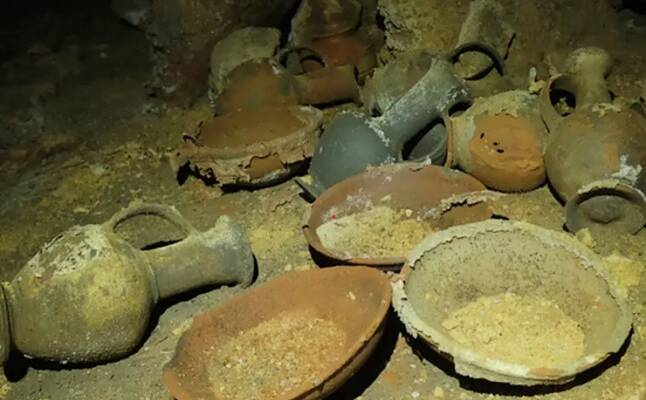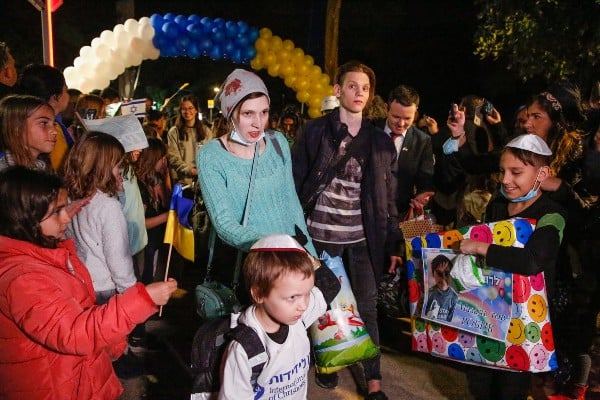The year 2022 was another fruitful year for archaeological discovery in the Holy Land.
By Nosson Shulman
Israel is one huge archaeological site! Since almost any location in the country could literally be on top of buried ancient treasure, there is a strictly enforced law. Prior to developers building anything (or before the government can add new infrastructure, such as widening a highway) archeologists must first excavate the site to see what lies beneath the ground. Additionally, because of the sheer volume of archeological sites in Israel (including several not yet discovered) it’s not unusual for major archeological finds to be discovered by individual hikers, and even children during family outings. In addition to these finds at previously unknown locations, many sites are already known to be rich with archeology. When funding for digs (which are very expensive) are secured, sites are dug with the expectation that major finds will be unearthed.
The year 2022 was another fruitful year for archeological discovery (for the top 10 list of 2021, click here). Hundreds of finds were discovered, many quite revolutionary in our understanding of past Biblical and historic events. While all of these findings deserve their own articles, I have narrowed down the list to what I believe were the top 10 finds:
Ancient Egyptian Burial Cave from the time of Pharoah Ramses the 2nd
In what some archeologists have described as a “Once in a lifetime” find, an extremely rare Egyptian burial cave from the time of Pharoah Ramses 2nd (who many believe is the Pharoah from Exodus) was located. Inside the cave were fully intact weapons, vessels (including bowls, chalices, cooking pots, oil lamps and jugs) some of which were painted red, and some had bones in them. The Egyptians believed that in the journey to the afterlife these items would be needed, so they were buried with them.
This burial cave was discovered accidently in the Palmahim Beach National Park in central Israel when the drill of a mechanical digger (who was doing construction work) hit the roof of the structure. The burial cave, believed to be about 3300 years old, had been completely sealed until it was discovered last year. Because the archeologists were the first people to gain access in more than three millennia (unlike most Egyptian sites, this one was not looted in ancient times), entering the cave was like entering a time capsule. This will allow researchers to understand ancient funerary customs like never before. One of the archeologists compared these findings to a set on Indiana Jones.
The lesser-known story of the Egyptians controlling the land of Israel began with Pharoah Thutmose III, who invaded in the 15th century BCE. For the next 350 years approximately (including the time when the Jews were slaves in Egypt) they controlled the land and allowed the local Canaanite city-state Kings to stay in power as long as they didn’t rebel. Their rule remained until the Biblical Exodus when the army of Pharoah (probably Ramses 2nd) was drowned in the Sea of Reeds, and the Egyptians lost all of their overseas empire practically overnight.
The world’s oldest lice comb ever found, inscribed with the only full sentence ever discovered in the ancient Canaanite language
During a dig at the extraordinary Biblical site of Lachish (for more on that site, click here), a 3700-year-old ivory lice comb was found (dating to around the times of Biblical Patriarchs: Abraham, Isaac, and Jacob). This makes the comb the oldest such product ever found anywhere. The comb had 14 teeth for lice and eggs. Between two of them, the remains of an ancient louse were discovered.
What makes this comb extra valuable to researchers is the inscription in the ancient Canaanite language which says “May this tusk root out the lice of the hair and the beard”. This is the oldest complete sentence ever found in the ancient language (it is believed that the Canaanites only developed their own written language a mere hundred years earlier). Since it was made with ivory, it is believed to have been imported from Egypt and thus owned by a wealthy person.
Extremely rare collections of decorated ivory plaques (possibly the same ones mentioned explicitly in the Bible) discovered in Jerusalem for the first time
Archaeologists digging under the (former) Givati parking lot in the City of David in Jerusalem, were stunned to uncover a large collection of ivory plagues (more than 1500 fragments) dating to the Biblical First Temple period. It was discovered inside what was once an extremely luxurious palace (circa 9th and 8th century BCE), destroyed by the invading Babylonians (circa 422 BCE) by fire. This is the first time that they have been found in Jerusalem, and few have been located elsewhere in the world.
Ivory was perhaps the most valuable raw material in the ancient world (even more than gold). What made them so valuable was that they were from elephants in Africa and needed to be imported from a great distance. Based on other places where they have been located, it is believed that they were probably set inlaid into wooden couch thrones.
Based on the location and time period, it is possible that they belonged to King Solomon, whom the Bible records as having received a shipment of ivory from abroad (see 1 Kings 10:22), using it to build a throne (see 1 Kings 10:18). If it did indeed belong to the righteous king, it would appear that his descendants continued to use it for generations until the destruction of the First Temple. Similar findings have only been found in a few other capital cities of great Kingdoms from that time period, including Sennacherib’s palace in Nineveh (capital of Assyria) and in Samaria, the capital city of the northern kingdom of Israel (Jerusalem was in the southern kingdom of Judea). The ivory in Samaria may have belonged to King Ahab (see 1 Kings 22:39).
Other valuable items found in the ancient Jerusalem palace include jars used to hold vanilla-spiced wine, a seal made of agate (a semi-precious stone), and a seal impression inscribed with the words “Natan-Melech servant of the King”).
A 3200-year-old curse text bearing the oldest Hebrew text ever found. The name of G-d in Hebrew is written on it
While still in the wilderness (see Deuteronomy 11 and 27), the Children of Israel were commanded that when they would enter the Holy Land, 6 tribes would utter their famous curses on Mount Ebal (for more on that great site, click here). In Joshua 8, this commandment was carried out. Joshua then built an altar on the mount (which is still visible).
In 2019, excavations of the dirt by the altar unearthed a tiny amulet (2 by 2 cms), dated to the time of Joshua. In 2022, the inscription was finally deciphered and says “Cursed, cursed, cursed – cursed by (G-d’s name) .You will die cursed. Cursed you will surely die. Cursed by (G-d’s name) – Cursed, Cursed, Cursed.” The archeologist who discovered it said it may have been used in a ceremony (especially as it was discovered by the altar).
Although all words of the Torah are truth and do not require archeology to back up its validity, for academics who subscribe to the Biblical minimalist camp, this is a major blow. Several said that Moses could not have written down words of Torah because they think that Hebrew as a written language came much later. In fact, many of them claimed (despite thousands of years of Jewish religious texts which say to the contrary) that the ancient Israelites at this time were illiterate and only able to pass down information orally until they became literate.
The implications in academia are huge. According to Dr Scott Stripling, the archeologist who discovered the amulet “One can no longer argue with a straight face that the Biblical text was not written until the Persian period or the Hellenistic period as many higher critics have done, when here we do clearly have the ability to write the entire text at a much, much earlier date.”
1200-year-old rural estate and mansion discovered in the Negev Desert with a unique deep, subterranean system
Archeologists excavating in the Bedouin city of Rahat in Israel’s south, uncovered a 1200-year-old rural luxurious mansion, located between two unearthed old mosques. The complex, discovered deep underground, had a large courtyard surrounded by 4 wings with several rooms (many of the walls had high-end frescos covering them). Inside the house, large ovens for cooking were found. The house was likely owned by a wealthy landlord who oversaw farmsteads in the area.
The most impressive part of the complex was a subterranean, (well-constructed) system of stone vaults found 5.5 meters below the courtyard. It is believed that this was part of a cooling system which allowed the owners to store food and cold water (a massive cistern was found here) away from the hot desert sun. It is also believed that during the scorching summer months, these rooms were also used for entertainment. The system also allowed residents to go from one side of the building to the other without having to be exposed to the sun.
This find is significant for understanding that time period. According to the lead archeologist “Their high status and wealth allowed them to build a luxurious mansion that served as a residence and for entertaining; we can study the construction methods and architectural styles, as well as learn about daily life in the Negev at the beginning of Islamic rule.”
TO BE CONTINUED
Nosson Shulman is a journalist and Licensed Tour Guide in Israel specializing in Biblical tours. To allow tourists to experience Israel during the Corona era, he created the new hit Israel tour video series, which brings Israel to the home of viewers by simulating actual tours. To check out his free sneak preview tour videos, click here. To view sample tour itineraries or to inquire about private tour opportunities with a personalized itinerary on your next trip to Israel, click here.
Bring Purim Joy to Israeli Victims of War and Terror
Join us in providing Israeli victims of war and terror with much needed comfort, blessing and holiday joy.
Families have been destroyed by the horrific Hamas massacre of October 7th and ongoing terror and rockets attacks. There are so many orphans that need our love, compassion and support!
Brighten their Purim holiday by sending Purim food baskets, yummy treats, personal notes and toys for the children.
CLICK HERE TO SEND YOUR PURIM GIFT & PERSONAL NOTE TO THE VICTIMS



